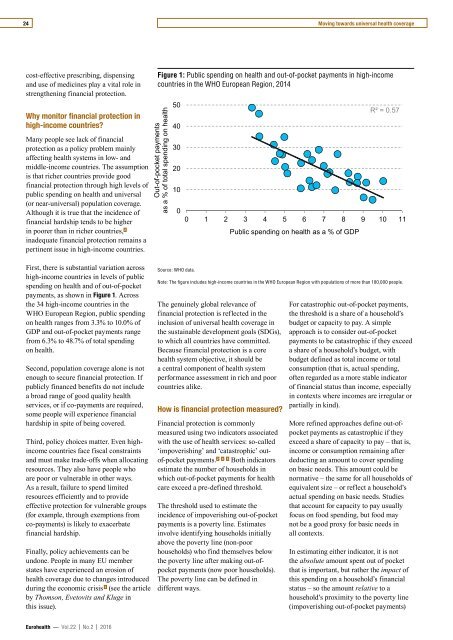EUROHEALTH
Eurohealth-volume22-number2-2016
Eurohealth-volume22-number2-2016
You also want an ePaper? Increase the reach of your titles
YUMPU automatically turns print PDFs into web optimized ePapers that Google loves.
24<br />
Moving towards universal health coverage<br />
cost-effective prescribing, dispensing<br />
and use of medicines play a vital role in<br />
strengthening financial protection.<br />
Why monitor financial protection in<br />
high-income countries?<br />
Many people see lack of financial<br />
protection as a policy problem mainly<br />
affecting health systems in low- and<br />
middle-income countries. The assumption<br />
is that richer countries provide good<br />
financial protection through high levels of<br />
public spending on health and universal<br />
(or near-universal) population coverage.<br />
Although it is true that the incidence of<br />
financial hardship tends to be higher<br />
in poorer than in richer countries, 2<br />
inadequate financial protection remains a<br />
pertinent issue in high-income countries.<br />
Figure 1: Public spending on health and out-of-pocket payments in high-income<br />
countries in the WHO European Region, 2014<br />
Out-of-pocket payments<br />
as a % of total spending on health<br />
50<br />
40<br />
30<br />
20<br />
10<br />
0<br />
R² = 0.57<br />
0 1 2 3 4 5 6 7 8 9 10 11<br />
Public spending on health as a % of GDP<br />
First, there is substantial variation across<br />
high-income countries in levels of public<br />
spending on health and of out-of-pocket<br />
payments, as shown in Figure 1. Across<br />
the 34 high-income countries in the<br />
WHO European Region, public spending<br />
on health ranges from 3.3% to 10.0% of<br />
GDP and out-of-pocket payments range<br />
from 6.3% to 48.7% of total spending<br />
on health.<br />
Second, population coverage alone is not<br />
enough to secure financial protection. If<br />
publicly financed benefits do not include<br />
a broad range of good quality health<br />
services, or if co-payments are required,<br />
some people will experience financial<br />
hardship in spite of being covered.<br />
Third, policy choices matter. Even highincome<br />
countries face fiscal constraints<br />
and must make trade-offs when allocating<br />
resources. They also have people who<br />
are poor or vulnerable in other ways.<br />
As a result, failure to spend limited<br />
resources efficiently and to provide<br />
effective protection for vulnerable groups<br />
(for example, through exemptions from<br />
co-payments) is likely to exacerbate<br />
financial hardship.<br />
Finally, policy achievements can be<br />
undone. People in many EU member<br />
states have experienced an erosion of<br />
health coverage due to changes introduced<br />
during the economic crisis 3 (see the article<br />
by Thomson, Evetovits and Kluge in<br />
this issue).<br />
Source: WHO data.<br />
Note: The figure includes high-income countries in the WHO European Region with populations of more than 100,000 people.<br />
The genuinely global relevance of<br />
financial protection is reflected in the<br />
inclusion of universal health coverage in<br />
the sustainable development goals (SDGs),<br />
to which all countries have committed.<br />
Because financial protection is a core<br />
health system objective, it should be<br />
a central component of health system<br />
performance assessment in rich and poor<br />
countries alike.<br />
How is financial protection measured?<br />
Financial protection is commonly<br />
measured using two indicators associated<br />
with the use of health services: so-called<br />
‘impoverishing’ and ‘catastrophic’ outof-pocket<br />
payments. 2 4 5 Both indicators<br />
estimate the number of households in<br />
which out-of-pocket payments for health<br />
care exceed a pre-defined threshold.<br />
The threshold used to estimate the<br />
incidence of impoverishing out-of-pocket<br />
payments is a poverty line. Estimates<br />
involve identifying households initially<br />
above the poverty line (non-poor<br />
households) who find themselves below<br />
the poverty line after making out-ofpocket<br />
payments (now poor households).<br />
The poverty line can be defined in<br />
different ways.<br />
For catastrophic out-of-pocket payments,<br />
the threshold is a share of a household’s<br />
budget or capacity to pay. A simple<br />
approach is to consider out-of-pocket<br />
payments to be catastrophic if they exceed<br />
a share of a household’s budget, with<br />
budget defined as total income or total<br />
consumption (that is, actual spending,<br />
often regarded as a more stable indicator<br />
of financial status than income, especially<br />
in contexts where incomes are irregular or<br />
partially in kind).<br />
More refined approaches define out-ofpocket<br />
payments as catastrophic if they<br />
exceed a share of capacity to pay – that is,<br />
income or consumption remaining after<br />
deducting an amount to cover spending<br />
on basic needs. This amount could be<br />
normative – the same for all households of<br />
equivalent size – or reflect a household’s<br />
actual spending on basic needs. Studies<br />
that account for capacity to pay usually<br />
focus on food spending, but food may<br />
not be a good proxy for basic needs in<br />
all contexts.<br />
In estimating either indicator, it is not<br />
the absolute amount spent out of pocket<br />
that is important, but rather the impact of<br />
this spending on a household’s financial<br />
status – so the amount relative to a<br />
household’s proximity to the poverty line<br />
(impoverishing out-of-pocket payments)<br />
Eurohealth — Vol.22 | No.2 | 2016
















